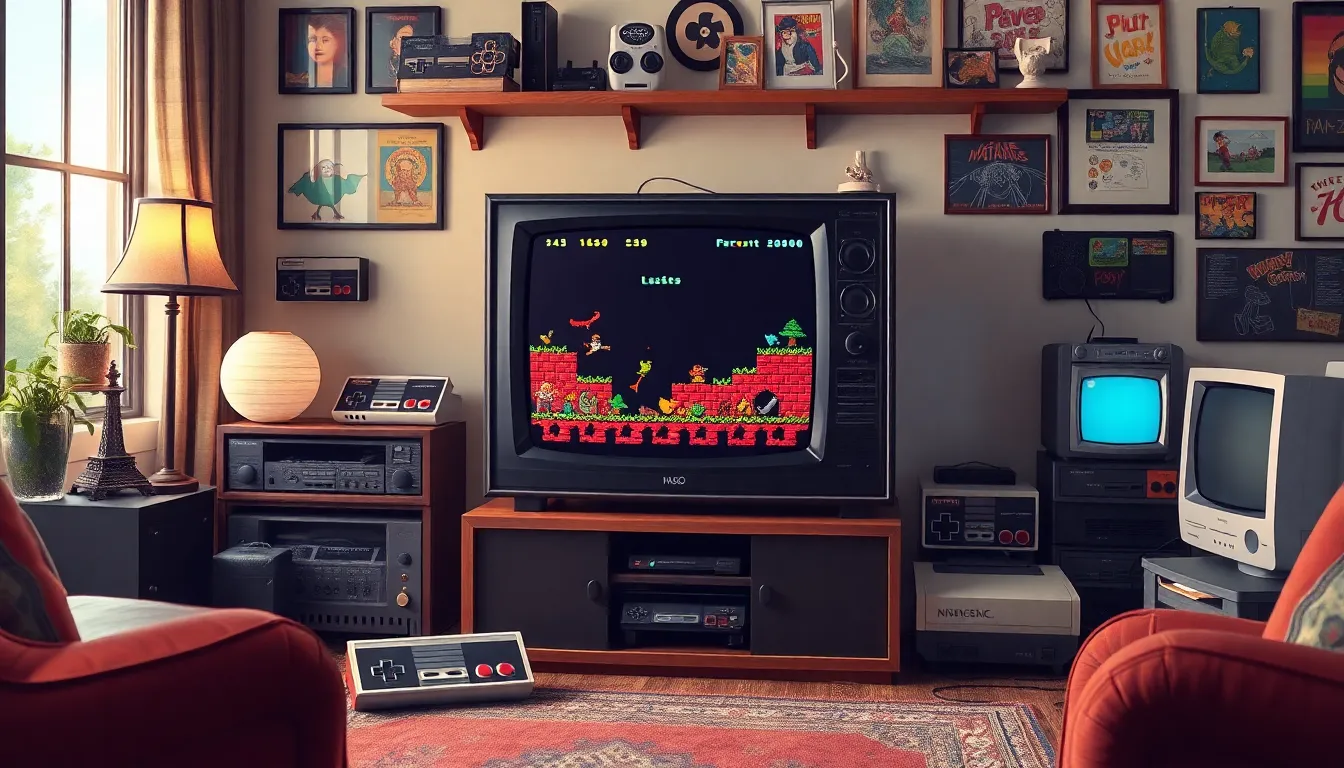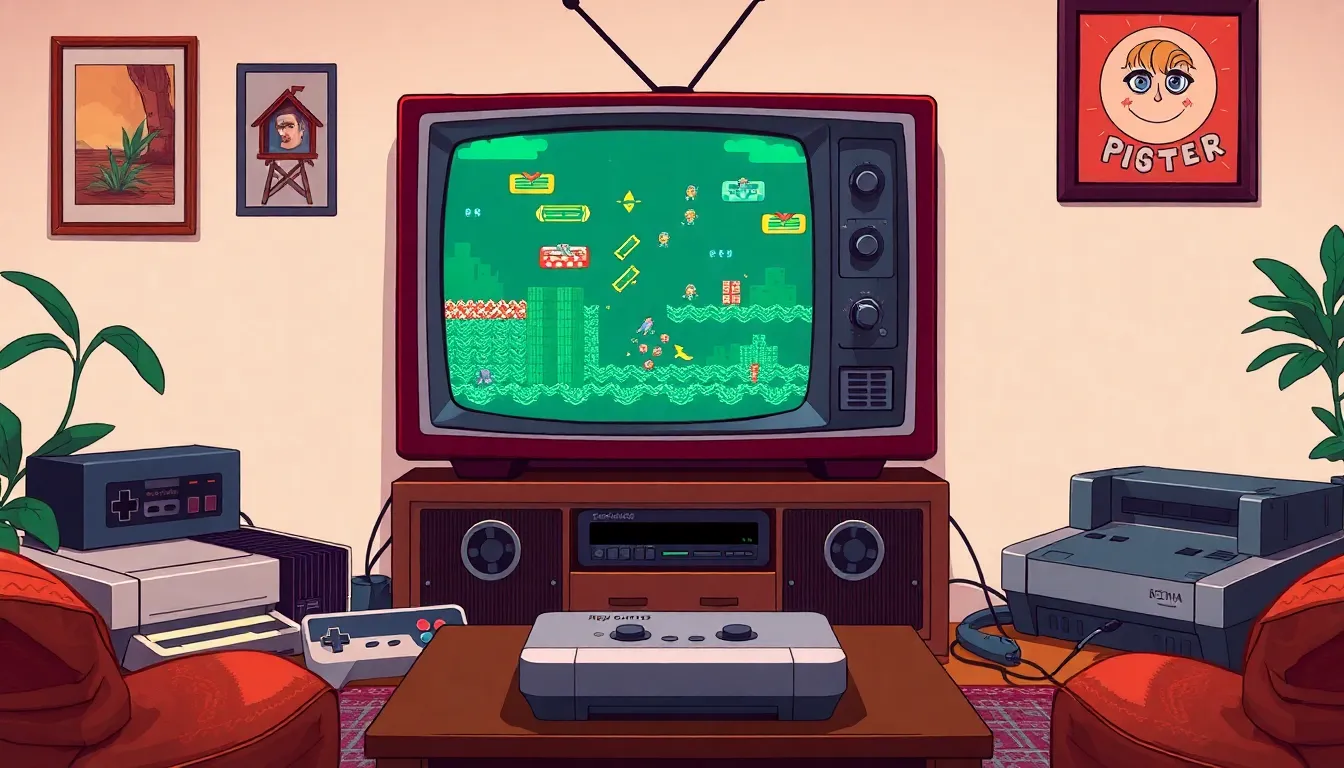Phone:
(701)814-6992
Physical address:
6296 Donnelly Plaza
Ratkeville, Bahamas.

For gamers who fondly remember the pixelated glory of the ’80s and ’90s, finding the perfect TV for retro gaming isn’t just a task; it’s a quest worthy of a heroic RPG. The right screen can transform a simple gaming session into a nostalgic journey through time, where every jump and power-up feels like an epic achievement. But with so many options out there, how does one choose?
Retro gaming represents a desire to return to the classic games and consoles that defined earlier generations. It evokes feelings of nostalgia, showcasing unique graphics and gameplay that stand out in today’s gaming landscape.
Retro gaming refers to playing video games from earlier generations, often from the ’70s, ’80s, and ’90s. These games exhibit distinctive pixel art styles, simple mechanics, and memorable soundtracks. Many gamers embrace retro gaming as a way to relive cherished memories or experience games that influenced the industry. Enthusiasts often seek original hardware or emulators to play these classic titles. Retro gaming communities thrive online, where fans share tips, tricks, and modified versions of these beloved games.
Several consoles shaped the retro gaming landscape, each leaving a significant mark. The Atari 2600, known for pioneering home gaming, introduced iconic titles like “Pong” and “Space Invaders.” Nintendo Entertainment System (NES) followed, revitalizing the gaming industry with classics like “Super Mario Bros.” and “The Legend of Zelda.” Sega Genesis provided a worthy competitor, offering renowned games such as “Sonic the Hedgehog” and “Street Fighter II.” The Super Nintendo Entertainment System (SNES) gained acclaim for its rich library of titles, including “Donkey Kong Country” and “Final Fantasy.” These consoles capture a golden era of gaming that continues to captivate new players today.

Selecting the right TV for retro gaming involves considering several key features that enhance the nostalgic experience.
Classic games were designed for lower resolutions, so choosing a TV with a resolution that matches these older consoles is crucial. A resolution of 480p or 720p often works best for 8-bit or 16-bit systems. Displaying retro graphics in their intended form preserves the pixelated charm. For gamers seeking clarity, some newer TVs offer retro mode options, adjusting the resolution to avoid blurring. Furthermore, upscaling capabilities can help when using original hardware on modern screens.
Input lag significantly impacts gameplay, especially in fast-paced retro titles. An ideal retro gaming TV should have an input lag below 30 milliseconds. Lower lag ensures responsiveness, which is vital for platformers and shooters. Lag can disrupt gaming flow and challenges, frustrating players. Many modern TVs offer gaming modes that reduce input lag when a console is connected. Checking for reviews on lag performance can guide buyers towards the best options.
Retro games commonly use a 4:3 aspect ratio, fitting the original screens of classic consoles. Finding a TV that supports this aspect ratio provides an authentic gaming experience. Some TVs offer options to maintain the original format without stretching the image. Alternatively, gamers can choose widescreen models with settings to display games in their native aspect. When enjoying older titles, aspect ratio plays a key role in visual fidelity.
Different display technologies affect the visual quality of retro games. LCD and OLED TVs deliver vibrant colors, but older CRT displays may emulate the authentic ’70s and ’80s feel. A TV with excellent color accuracy replicates the nostalgic vibe of classic graphics. Some models feature settings that simulate the look of CRT displays, softening edges for a more authentic experience. Assessing display technologies helps gamers choose models that enhance their favorite titles.
Selecting the right TV can significantly enhance the retro gaming experience. Below are some top picks tailored for gamers seeking to enjoy classic titles.
Both LCD and OLED options cater to different preferences in retro gaming. LCD TVs offer vibrant colors and are generally more affordable. Gamers who prioritize budget might gravitate towards these models. Conversely, OLED screens provide excellent contrast and deeper blacks. Those who want a striking visual presentation may find OLED better for immersive gameplay.
For budget-conscious gamers, the TCL 4-Series stands out as an excellent choice. This TV features 4K resolution, yet supports 1080p for older consoles. With low input lag under 20 milliseconds, this model ensures responsive gameplay. A reasonable price point makes it accessible, and its wide viewing angles enhance multiplayer sessions.
The LG OLED C1 delivers premium features ideal for retro gaming enthusiasts. This model supports 4K resolution and includes advanced gaming features like G-Sync compatibility. With an impressive input lag of just 5 milliseconds, responsiveness is unbeatable. The vibrant colors and deep contrasts elevate classic titles, ensuring that retro graphics shine.
For gamers craving an authentic CRT experience, the Sony PVM-20M2U delivers nostalgia in spades. This professional-grade CRT monitor provides stunning colors and realistic visuals. Gamers appreciate its low input lag and rich image quality, which perfectly captures pixelated graphics. Many also favor its flexibility with older consoles, making it a top choice for retro gaming aficionados.
Setting up a retro gaming TV involves careful calibration and the right accessories to enhance the overall experience.
Calibrating the TV ensures optimal picture quality for retro gaming. Start by adjusting the brightness and contrast settings to match the vibrant colors of classic games. Set the sharpness low to prevent unwanted artifacts that distract from pixel art. Color temperature should lean towards warm tones, reminiscent of older displays. Additionally, it’s crucial to disable any motion smoothing features as they can blur the classic graphics. Input settings should match the resolution of your console, with 480p or 720p being ideal for authenticity. Each of these changes contributes to a nostalgic visual experience, reminiscent of the original hardware.
Accessorizing the gaming setup can enhance the experience significantly. A quality HDMI to VGA adapter ensures compatibility with vintage consoles. Selecting a gaming-specific controller can improve playability and comfort during long sessions. Using retro gaming speakers or a decent soundbar provides audio clarity that matches the original soundtracks. A CRT shader or scanline generator can simulate the look of traditional CRT screens on modern displays. Finally, a good quality surge protector protects valuable equipment from power spikes. These accessories complement the gaming TV setup, allowing enthusiasts to immerse themselves in classic gaming adventures.
Choosing the right TV for retro gaming can transform the experience into a nostalgic journey. With options ranging from affordable LCDs to premium OLEDs and authentic CRTs, there’s something for every gamer. The ideal TV combines low input lag with the right resolution and aspect ratio, ensuring classic titles shine as they were meant to.
By paying attention to calibration and investing in quality accessories, players can create an immersive environment that brings their favorite games back to life. Embracing the charm of retro gaming means finding the perfect screen to match those cherished memories, allowing both old and new generations to enjoy the magic of pixelated adventures.